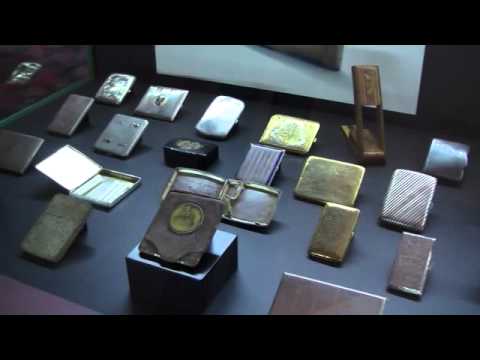Tobacco Museum
Background
Following an agreement in 1989 between the City Museum of Ljubljana and the Tobačna Ljubljana company, the former, assisted by external collaborators, started to research and collect material relating to the history of tobacco and its production as well as to the history of the tobacco factory. On 21 March 1991 the museum presented the results of its activities in a one-month exhibition called Tobacco and its Thrills at Križanke Cultural Information Centre. The exhibition was the most prominent event of the Tobacco Factory's 120th anniversary celebrations. Complemented and enhanced, this exhibition subsequently became the basis for a permanent museum collection in the renovated premises of the former warehouse of Tobačna Ljubljana. On 9 April 1992 this collection was declared a cultural monument and opened to the public as the permanent collection of the Tobacco Museum.
Collection
The new display was designed by Boris Balant and placed in the former workers' bathrooms. The first part of the museum presentation is chronologically-arranged and presents 140 years of the Ljubljana Tobacco Factory, the organisation of the state monopoly, and the construction of a large new complex of factory buildings in the area between the Southern Railway and Tržaška cesta (one of the city's main boulevards, leading out of town to the southwest). This complex of buildings is a splendid example of industrial architecture from the latter half of the 19th century.
The collection aims to present to the visitor the significance and role of the Tobacco Factory and the way of life of its workers over the past 120 years. At the end of the 19th century the Tobacco Factory employed nearly 2,500 workers (8 % of the inhabitants of Ljubljana at the time). Owing to the specific nature of the production most of them were women. The legacy of the cigararice ("cigar ladies"), the women who made cigars, has not been forgotten, because they left their mark in some of the town's neighbourhoods.
The collection introduces the visitor to the production processes of different tobacco products. The factory began its operation with handmade cigar production, but soon expanded to the production of cigarettes, pipe tobacco, snuff, chewing tobacco and tobacco extract. The collection highlights the product which made the Tobacco Factory of Ljubljana famous throughout Europe in the previous century, the so-called "Virginian" cigar. The collection also draws attention to the development of the culture of smoking as well as to different conceptions of the healing properties and health risks of tobacco. Of special interest to the visitor are the precious collections of pipes from different periods, tobacco and cigarette cases, cigar and cigarette holders, the products of the tobacco factory over the past seven decades and their packaging, and works of art on smoking.
Former factory as a venue
During the last decade the former Tobacco Factory premises have served as an important contemporary visual arts exhibition venue. The 2005 edition of the Biennial of Graphic Arts) was presented in the main building, while the nearby T5 Project Space was later the venue for the Pecha-Kucha Night events.
At Tobačna 001, a new cultural centre inaugurated in March 2011, the Tobacco Museum collection, a new exhibition space, and an apartment for resident artists can be found.
See also
- Tobačna 001 Cultural Centre
- City Museum of Ljubljana
- Museum and Galleries of Ljubljana
- T5 Project Space


